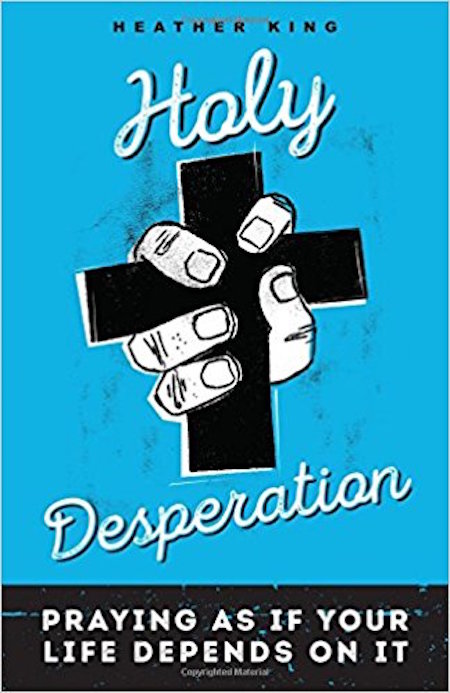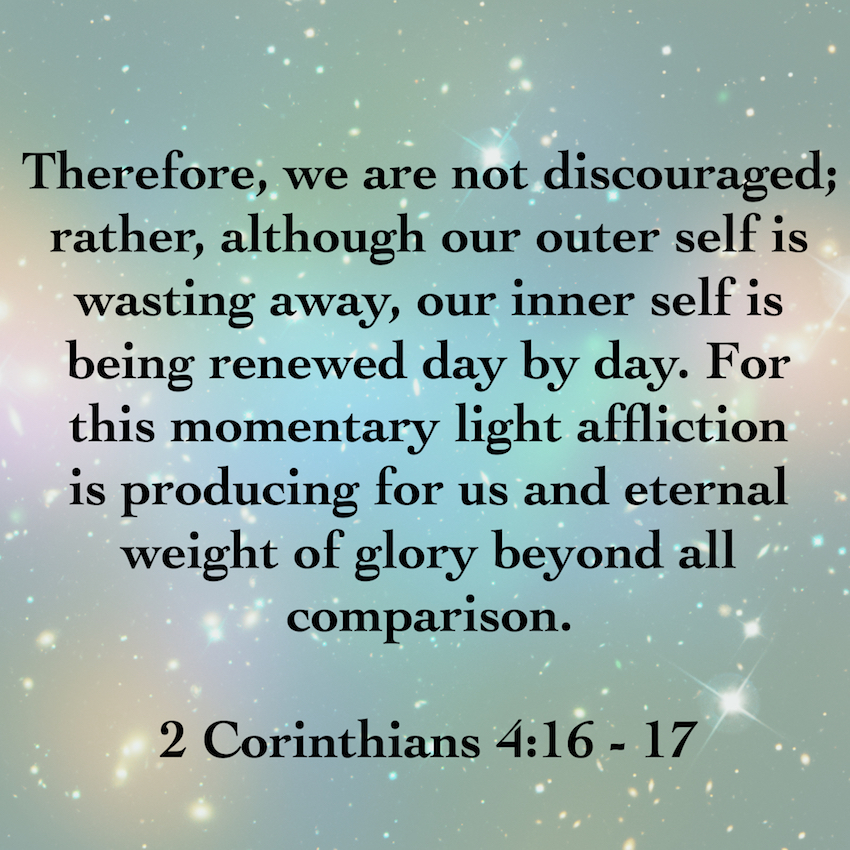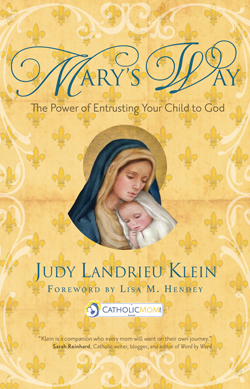How much time do you spend in your mind, lost in world of racing thoughts concerning anything and everything but the present moment? Do you find yourself habitually living in a state of anxious deliberation fueled by past ponderings or future fears— instead of being fully present to God, yourself and others?...
Read moreWhen God Lets Us Wait: The Hidden Grace of Unanswered Prayers
Here we go again, you may be moaning as a painful situation rears its ugly head one. more. time. Perhaps you’ve prayed for a miracle for years, decades, even a lifetime. Maybe you’re exhausted from asking God to answer a prayer, or just flat angry at him for apparently not hearing you—especially if you’ve begged incessantly for something good, like a healing, conversion, or cure—something God would surely want, right?...
Read moreA Potent Prayer for the Healing of the World
With the world teetering on the edge of nuclear war and anxieties running high, I humbly share with you a powerful prayer for healing and conversion given to me some months ago in prayer before the Blessed Sacrament. This prayer grew out of the recognition that we can “stand in the gap” in intercessory prayer like Abraham (Gen. 18:23), Moses (Exodus 32:11-14), and Ezekiel (Ez. 22:30), pleading for God’s mercy upon us and upon our broken world...
Read moreBig News! ...And a Book Review
Dear Friends, Happy Summer! Yes, I've been a bit quiet lately, and there's a reason for that. I've been studying again----this time for PhD in Pastoral Counseling!
I am beyond thrilled to announce that I'll be hanging my shingle as a counselor at My Father's House Counseling in August, and that I will soon be working beside my husband, Mark Gelis, in the Christian Counseling Ministry. I am waiting for my license as a Certified Temperament Counselor to arrive from the National Christian Counseling Association as I write this, and I will receive my Doctoral Degree and accompanying license as a Pastoral Counselor by the end of the year.
I will continue to blog regularly here, at Aleteia, and at CatholicMom.com. I have also begun writing for Catholic Digest in both their print and online journals, so look for new articles there.
Life is busy, and I would greatly appreciate your prayers as I begin this new endeavor. Mark and I have prayerfully discerned this move together, and I look forward to finally working with him to bring healing and restoration to hurting souls.
Meanwhile, if you're looking for a great summer read, please do check out Heather King's "Holy Desperation" (or any and all of her eleven books for that matter!)
Many blessings and graces to you and yours as we conclude the summer weeks.
Judy
 Heather King knows all about praying as if her life depended on it, because her life literally did. After spending twenty solid years in what she calls “a twilight-zone alcoholic haze,” King’s knees finally hit the ground in desperation after a moment of “clarity” during which she realized she had to give up the drink or die.
Heather King knows all about praying as if her life depended on it, because her life literally did. After spending twenty solid years in what she calls “a twilight-zone alcoholic haze,” King’s knees finally hit the ground in desperation after a moment of “clarity” during which she realized she had to give up the drink or die.
I was strung out and half-drunk, and I had a cigarette in my hand. I was thirty-four and it was the first time in my life I had ever sincerely prayed.
That desperate prayer over thirty years ago got King sober, and the prayers she’s prayed ever since have converted her, healed her and awakened her to God and to life—a story she tells in her eleventh book, Holy Desperation: Praying As If Your Life Depends On It.
King’s jagged journey eventually led her into the Catholic Church, where she now spends her days as a “contemplative laywoman” and a writer—with the passion that’s consumed her ever since she “woke up” from a “semicomatose haze of loneliness, depression, self-pity, neurotically self-centered fear, and paralysis.”
King doesn’t hold back, whether it comes to sharing her struggles or her love of the Catholic Church:
One thing I love about the Catholic Church is that it attracts nutcases. Otherwise, how could there be a place for me?
I love it all: Mass, the angels and saints, holy days, incense, candles, bloody statues, relics, pilgrimages. I especially love that miracles—and the “simple,” “deluded” people who claim to have experienced them—tend to drive nonbelievers mad.
Aside from the radical honesty and profound wisdom with which Holy Desperation is filled, this book is a must read for the sheer joy of savoring King’s prose, which offer a thoroughly relevant, fresh presentation of the Gospel that is both humorous and theologically astute. King writes:
I used to think I was open-minded because I’d invite the cabdriver upstairs. No, no, that’s not open-mindedness. That’s promiscuity. That’s looseness.
The open-mindedness, honesty, and willingness required in our quest for God seem to involve an imagination that’s willing to catch fire: a capacity to be moved, to be touched, to have a sense of humor about ourselves, a taste for the wild-card surprise; and a profound awareness of our vulnerability, brokenness, and need.
Beyond King’s clarity and honesty, Holy Desperation is a deep tome on prayer, conversion and inner transformation. So much so that I’d say it’s the most challenging, daring articulation of the Gospel I have read in a long time. In fact, I found myself stopping to pray and reflect on practically every page as I was prompted to take a personal inventory of my own willingness to let God love me, transform me, and use me as his instrument to love and serve others. King’s book drove me not just to prayer but to change, which she proposes should be a major fruit of a relationship with Christ and a life of prayer. As King puts it:
We’ll come to agree with the Church’s teachings, including those on the family, abortion, euthanasia, capital punishment, capitalism, usury, war, and violence of all kinds. We won’t arbitrarily pluck out one or two isolated issues that happen to be easy for us to follow and ignore the many teachings we’d rather not look at too closely because they might require the very kind of radical change we so vociferously demand of others.
With utter orthodoxy and blistering accuracy—and without being the least bit preachy—King names and critiques many of the idols we must confront and stare down in ourselves and in the culture if we are to become more Christ-like. Her point is that prayer is meant to equip us to do just that: by giving us hearts that more readily seek God, eyes that more easily see God, hands that more willingly share God and the humility to openly admit that we’ll never really “get” God. As the contemplative writer observes, "Prayer doesn’t make us more excellent. If we’re lucky, prayer makes us more human."
Amen, Heather King. And thanks for not only a great read, but for a beautiful, timely and sorely needed enunciation of the central truths of our faith.
This article was previously published at Aleteia.
The Healing Power, and Victory, of Embracing Change
There is an appointed time for everything, and a time for every thing under the heavens. Ecclesiastes 3:1
It was an epiphany of sorts, coming forth as a season of change presents itself. In the midst of a series of painful life adjustments, I admitted for the first time that I don’t like change. During a moment of insight, I suddenly understood that I associate change with chaos, uncertainty and pain, and with having the rug pulled right out from under my feet.
How many of us experience change this way?
As it often happens when God opens up a theme for metanoia (which means to change one’s mind and heart about something), all of life’s conversations and events suddenly seemed to segue into one single exclamation point. This week’s lesson in change was no exception.
First, there was the butterfly that lay on the ground in front of the chapel: a gorgeous creature decorated with brilliant fall colors that appeared to be trying to flutter its wings. Spontaneously, I leaned over and picked it up, only to realize that its wing was broken and that ants were already eating its corpse. Putting the butterfly back in its place, I went into the chapel to pray. There, I opened my spiritual reading to a page that, of all unexpected things, was discussing the butterfly as a metaphor for the spiritual life.
That got my attention.
A butterfly is probably the quintessential image of change: a being whose existence comes about by a metamorphosis that literally transforms a creature into something new, and quite often, into something stunningly beautiful. As I prayed with the image, it became quickly obvious that the broken-winged butterfly represented how I’ve tended to view change—not as something transformative and life giving, but as something traumatic, and even potentially deadly.
I could almost hear God whispering: Could it be time to embrace a new understanding of change?
My next stop was an Al-Anon meeting, where the topic of the day was…you guessed it: Change! It seems that a common theme among those adversely affected by the insanity of addiction is a strong resistance to change. Like me, many people healing from addiction’s fallout equate change with chaos and uncertainty—and with holding one’s breath to brace for what’s coming next. But the real insight of the meeting was that a person must be proactive about change in order to find healing. In fact, choosing to change is often absolutely necessary for new life to emerge.
This brought me back to the butterfly. Wanting to understand how metamorphosis occurs, I began to search the internet when I returned home. I was fascinated to learn that scientists often equate a caterpillar’s morphing into a butterfly with death and resurrection, a point that brought the whole lesson full circle. The greatest change that has ever happened in history—the greatest metamorphosis that’s ever taken place in the universe—was the Resurrection of Jesus Christ, which happened only after Jesus willingly chose to embrace death, and all of its accompanying terrors, to change the corruptible into what is incorruptible, and death itself into victorious new life.
Personal change usually involves our willful acceptance of many deaths—the death of our ways, our wills, our wishes—for the promise of new life. And little by little, through a process of transfiguration that takes time and patience, we begin to find our interior hardware radically rearranged unto glory, that we might alight with new wings that bear his brilliance—wings that can only burst forth by the shedding of the old and the awakening to the new. In a word, through change.

This article was previously published at Aleteia.
Have you consecrated your child to the Immaculate Heart of Mary? Click here to download a free "Mary's Way" Consecration Prayer.
My New Book Release: Mary's Way
 Dear Friends,
Dear Friends,
I am happy to be back at my desk after taking a three week sabbatical from writing due to the death of my father and other family commitments. First of all, let me thank those of you who knew of my dad's illness for your prayers and support. He experienced a beautiful, holy death and was buried on the Feast of Our Lady of Mt. Carmel, a most special feast day to me. I am so very grateful to the Lord for the many graces that my dad and our entire family received during his illness and death. I will be sharing some of those later this week in a blog post. God is so good and merciful!
I also wanted to share with you the news of the publication of my new book, Mary's Way: The Power of Entrusting Your Child to God, which will be released on The Feast of St. Monica, August 27. This book is a true labor of love; written in prayer and tears as I reflected upon and retold stories of the miracles God has worked in our lives in the midst of deep suffering. It is my ardent prayer that Mary's Way will not only help parents and grandparents pray more effectively for their children and grandchildren, but that it will bring honor to Our Lady, who has helped our family countless times and in countless ways.
I am delighted by the response the book has received thus far by those who have previewed it, including the following testimonials:
"With poignant and relatable storytelling, Judy invites us into the intimacy of her profound sorrows as a wife, mother, sister, and daughter in the hopes that the lessons of faith she learned will benefit us in our own struggles. If you're a mother or grandmother, you need Mary's Way." Kitty Cleveland, Author, Speaker, Singer
"No matter how great the struggle, God has a way and can bring you through. A great message of encouragement...you clearly made the point that faith and prayer made all the difference...Some of your insights regarding Mary's life and the power of the cross blew me away!" Carol Marquardt, Author
"I am at 35,000 feet and just finished your beautiful book! My heart is bursting and my eyes filled with tears. You have done it again. What a gifted writer you are. Thank you for sharing yet more of your faith and life with so many. I can't wait to order several copies. As I was reading, God placed several people on my heart who I want to give the book to. Can't wait it share with them!" Kelly Reed, Theology teacher
You can pre-order your copy of Mary's Way now at Amazon. Please join me in honoring Our Lady as we learn how to live and pray "Mary's Way."
Blessings and grace to you and yours,
Judy

How To Find God in A World Full of Chaos

To repeat continually “for his mercy endures forever,” as the psalm does, seems to break through the dimensions of space and time, inserting everything into the eternal mystery of love. It is as if to say that not only in history, but for all eternity man will always be under the merciful gaze of the Father. Pope Francis, Misericordiae Vultus, para. 7
“Let us remember that we are in the holy presence of God.” That reminder begins every class and every assembly at St. Paul’s School, the Catholic high school that my 16-year-old son, Benjamin, attends.
We are in the holy presence of God. Do we believe it? Do we live as though it’s true?
As the world seemingly spins out of control, we can wonder: Where is God in all of this? Caught in the vortex of the world’s chaos, we can feel our center slipping. How do we find rest?
To begin with, we must be intentional about how we spend our time, living with a lively awareness of whether what we do with our time facilitates internal peace or chaos in our lives. We can develop chaos-free habits of living, the most important of which is spending time with God daily in prayer (which, ironically, is the thing we often avoid most). Indeed, “wasting” precious time with God in prayer is the most vital thing we can “do” on any given day, even if it’s just for a few minutes. Jesus spent lavish time in prayer regularly—he “often withdrew to lonely places and prayed” (Luke 5:16). If the God-man needed to pray, how much more do we pitiful sinners need to?
Prayer awakens us to the presence of God, who is always with us. Prayer calls us to center ourselves on God, who as St. Augustine said, “is closer to us that we are to ourselves.” Prayer intentionally pushes back the unholy pandemonium in our lives by reordering our hearts and minds to God. Because the chaos in our lives is often a reflection of the chaos in our hearts and heads. In fact, when our insides become a place of mayhem, our outsides generally follow suit.
It seems that the more chaotic we feel inside, the more we experience ourselves as being “scattered.” Jesus said: “Whoever does not gather with me scatters” (Luke 11:23). It is interesting to note that the New Testament term for the dark power, ho diabolos, from which we derive the word “devil,” literally means “the scatterer.”* The “scatterer” specializes in chaos, disorder, division and disintegration—in keeping us dispersed in umpteen ways until we are beside ourselves.
The good news is that God’s promise is to gather us in from “every place where we (are) scattered” (Ezekiel 34:12). He continually invites us to intimacy with Him, to peace, order and integrity. He invites us to slow down, settle down and look up, praying with the psalmist: "I set the Lord ever before me; with him at my right hand I shall not be disturbed. Therefore my heart is glad and my soul rejoices, my body, too, abides in confidence." Psalm 15:8-9
A powerful remedy for chaos is to gather with God, and in so doing, allow him to gather us back from all of the places to which we have been scattered. As problems press in from every side, let us remember Christ’s words to anxious Martha that sitting at his feet is the one thing necessary (Luke 10:42)—one concrete act that can lead to peace, both in ourselves and in the world around us.
"The Lord is near. Be anxious for nothing, but in everything, by prayer and petition, with thanksgiving make your requests known to God. Then the peace of God that surpasses all understanding will guard your hearts and your minds in Christ Jesus." Philippians 4:5-7
*Thanks to Bishop Robert Barron for this insight.
This article was originally published on Aleteia.
Sowing Seeds of Faith
My good friend, Pat, was the first person I knew who returned to the Catholic Church. We struck up a deep friendship at a little evangelical church in New Orleans, and five years later the Blessed Mother brought us both back to the faith of our childhood. Pat who now lives in Asheville, N.C., recently launched a new ministry called “Theotokos Prayer.” The ministry evangelizes others and encourages them to pray through the vehicle of beautiful, handcrafted prayer strands. Each strand features personalized medals, crosses and colors which hold a special meaning for the recipient. My prayer strand, which Pat gave me as a wedding gift, has a medal of my patron, St. Jude, as well as a cross with the four major basilicas of Rome on it. I had it blessed by Pope Francis during our honeymoon in Rome and I absolutely love it!
It is my delight and honor to introduce to you “Theotokos Prayer” by sharing with you Pat’s first blog from their website. I encourage you to visit www.theotokosprayer.com to order a personalized prayer strand for yourself or someone you love. I promise, you will not be disappointed! Blessings and grace! Judy
How Theotokos Began
“That man has learned to live well who has learned to pray well.” St. Augustine
Theotokos began with a handmade gift of a St. Joseph’s chaplet. My dear friend, Betsy, had begun making chaplets and wanted to share this ministry with me. We then started to give them to the homeless, First Communion classes, family and friends. We discovered along the way that people of all denominations and walks of life were drawn to this form of prayer—using prayer strands on which to pray. Customizing the strands (which have the number of beads of a decade of the Rosary) by choosing specific beads and patron saints made the strands even more meaningful for the recipient. I would write letters to the recipients affirming God’s love for them and their family often during times of great struggle, as in the loss of a loved one, or deep joy, such as the birth of a child.
As this journey unfolded, friends and family encouraged me to develop a way to reach more people. Thus, Theotokos was born. The purpose of Theotokos, which means “God bearer” or “Mother of God” in Greek, is threefold. Foremost is to have people draw closer to God and each other through prayer. Secondly, to reach people who would not ordinarily be drawn to the Rosary, Our Blessed Mother and the Saints. Thirdly, to have the strands blessed, thereby fulfilling the request of the Blessed Mother for people to have blessed objects in their homes and on their person.
The Pope has called for creative ways to evangelize our culture and this endeavor seeks to do just that. There are moments in everyone’s life that are opportunities to reach out to our family and friends. These prayer strands are one simple way of reintroducing faith to the people in our circle of influence.
Currently there are five strands for specific occasions or needs: the Child Strand for the birth of a child, Baptism, or First Communion; the Family Strand to aid families in praying for one another; the Healing Strand for those suffering in all the forms our suffering may take; the Wedding Strand, and finally the New Orleans Saints strand (they need a lot of prayer). People are drawn to beauty and each of these strands is carefully crafted to be as beautiful and appealing as possible. I also have images enclosed with each prayer strand that evoke beauty, such as a picture of Mother Teresa or a bride with her new spouse. The one closest to my heart is of our eldest daughter, who died in 2001. This image of Ashley embracing her then two-year-old daughter so lovingly depicts the treasure of children.
Prayer is a gift that is meant to be shared with and for others. I am humbled at being able to bring this endeavor to fruition with the aid of the Holy Spirit and the inestimable help of dear friends accompanying me along the way. Thank you!
“Have no anxiety at all, but in everything, by prayer and petition, with thanksgiving, make your requests known to God. Then the peace of God that surpasses all understanding will guard your hearts and minds in Christ Jesus.” Philippians 4:6-7





